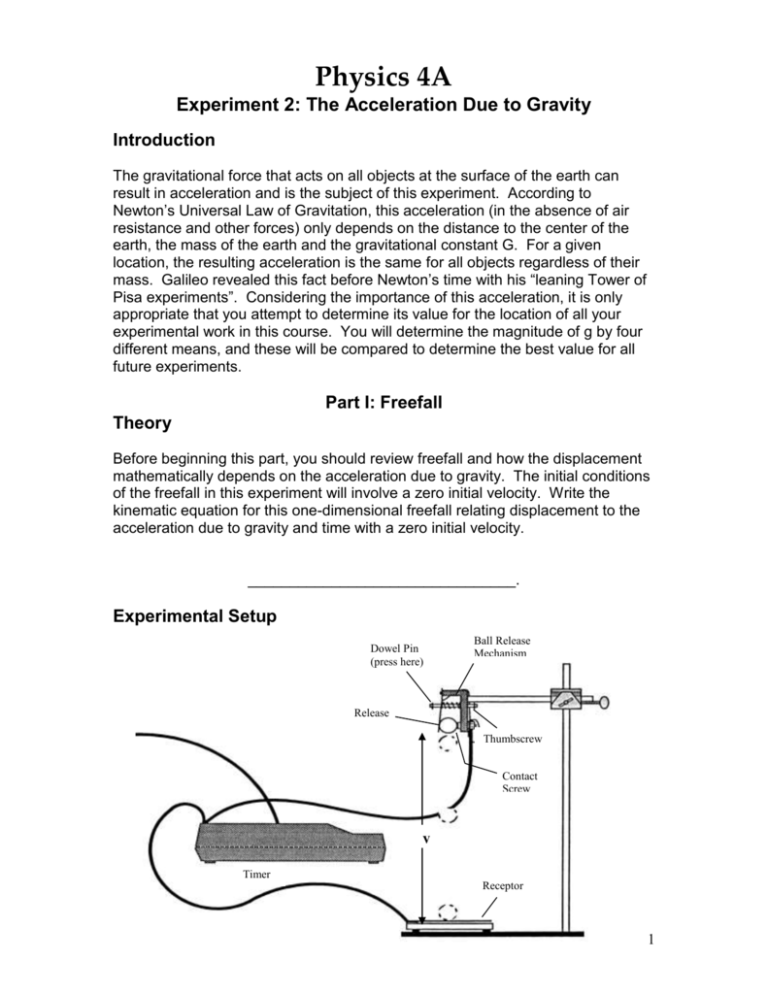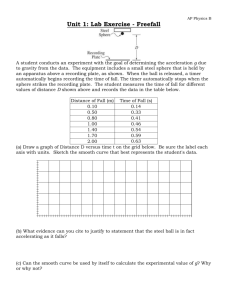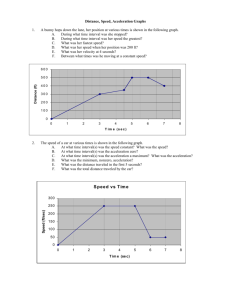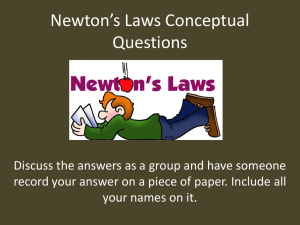Physics Lab: Determining Acceleration Due to Gravity
advertisement

Physics 4A Experiment 2: The Acceleration Due to Gravity Introduction The gravitational force that acts on all objects at the surface of the earth can result in acceleration and is the subject of this experiment. According to Newton’s Universal Law of Gravitation, this acceleration (in the absence of air resistance and other forces) only depends on the distance to the center of the earth, the mass of the earth and the gravitational constant G. For a given location, the resulting acceleration is the same for all objects regardless of their mass. Galileo revealed this fact before Newton’s time with his “leaning Tower of Pisa experiments”. Considering the importance of this acceleration, it is only appropriate that you attempt to determine its value for the location of all your experimental work in this course. You will determine the magnitude of g by four different means, and these will be compared to determine the best value for all future experiments. Part I: Freefall Theory Before beginning this part, you should review freefall and how the displacement mathematically depends on the acceleration due to gravity. The initial conditions of the freefall in this experiment will involve a zero initial velocity. Write the kinematic equation for this one-dimensional freefall relating displacement to the acceleration due to gravity and time with a zero initial velocity. ________________________________. Experimental Setup Dowel Pin (press here) Ball Release Mechanism Release Plate Thumbscrew Contact Screw y Timer Receptor Pad 1 Procedure 1. Check the apparatus to be sure it is set up correctly. Position the ball receptor plate directly under the ball. (You might want to place the receptor plate in a small box so the ball does not roll away after it falls.) 2. Set y, the height from which the ball drops, to approximately 1.80 meters. Measure the distance as accurately as possible (from the bottom of the ball to the top of the receptor plate) and record the distance in Data Table 1. 3. Insert a steel ball into the release mechanism. Press in the dowel pin so the ball is clamped between the contact screw and the hole in the release mechanism. Lightly tighten the thumbscrew to lock the ball in place. 4. Press the RESET button on the timer, and then loosen the thumbscrew so the ball drops. It should hit in the center of the receptor pad. If not, reset the timer, reposition the pad, and try it again. 5. Read the time on the digital display of the timer. This is the time it took for the ball to fall the distance y. Record the measured time as t1 in Data Table 1. 6. Repeat the measurement two more times and record values as t2 and t3. Calculate the average of your three measured times and record this value as tavg. 7. Repeat steps 2 to 6 by decreasing y each time by approximately 10 cm (measured accurately) and record the data in Data Table1 for a total of ten trials. Turn the timer off when you finished the data recording. Data Data Table 1 Trial y (cm) t1 (s) t2 (s) t3 (s) tavg (s) tavg2 (s2) 1 2 3 4 5 6 7 8 9 10 2 Analysis & Results 1. Plot a graph of y vs. tavg and y vs. tavg2 with y as the dependent value (yaxis) using Graphical Analysis or equivalent graphing software. Fit the two curves with the appropriate function and include “statistics” on both graphs. 2. From the statistics, determine the acceleration due to gravity and report both values in Table 2 below. Attach (or better “insert” here) your graphs to your report. Table 2: Freefall Results g (cm/s2) Quadratic Fit Linear Fit Part 2: g from the Simple Pendulum Theory A Simple Pendulum consists of a concentrated mass suspended at the end of a cord of negligible mass. A close approximation to this is a small metal sphere on a long, thin thread. When a simple pendulum swings through a small angle (< 5o), the motion closely approximates Simple Harmonic Motion. The period of the back and forth oscillations can be expressed as follows: T 2 L g where L is the length of the pendulum, and g is acceleration due to gravity. 3 Procedure 1. Locate the pendulum and use the cm caliper to measure the diameter of the ball. 2. Carefully lower the ball down until the string is fully extended. 3. Measure the length of the string by using a steel measuring tape. 4. Displace the ball to one side through an angle of no more then about 5 0 and let the pendulum oscillate. 5. Record the time it takes the pendulum to make 30 oscillations. Be sure to start the stopwatch on the count of zero and not on the count of one. 6. After you have finished, replace the ball on the ball holder. Analysis 1. Calculate the acceleration due to gravity by using the equation in the theory section (show your work below). Data & Results Table 3: The Simple Pendulum Diameter of Ball (cm) Length of String (cm) Length of Pendulum (cm) Number of Cycles Time (s) Period (s) g (cm/s2) Part 3: Helmert’s Equation 4 Theory Helmert’s Equation is an empirical result that allows one to calculate the acceleration due to gravity from northern latitude and elevation (above sea level) coordinates. This equation is shown below, where latitude is in degrees, minutes and seconds and elevation is in cm. g 980.616 2.5928 cos 2 0.0069 cos 2 2 3.086 x106 H northern latitude H elevation Using the net, see what you can find about this equation including history, accuracy and use. Include this information along with your sources in this theory. Procedure & Calculations 1. Using the net, find our northern latitude to the nearest second and our sea level elevation, and record these in Table 4. 2. Calculate our acceleration due to gravity and report it in Table 4. Show this calculation in the space below and watch your significant figures. Table 4: Helmert’s Equation Northern Latitude Elevation g (cm/s2) 5 Part 4: g from Newton’s Universal Law of Gravitation Theory In 1687, Isaac Newton presented an important equation summarizing the gravitational force behavior between two masses. This equation is shown below. FG G m1m2 r2 When one of the masses is the earth and the other is an object at the earth’s surface, then this equation can be used to calculate the acceleration due to gravity. Derive the equation for this calculation in the space below starting with Newton’s Law of Gravitation. Procedure & Calculations 1. Using the net, find an accurate value for the radius of the earth at our location and report it in Table 5. 2. Also find an accurate value for the mass of the earth and report it in Table 5. 3. Calculate the acceleration due to gravity and report your result in Table 5. Show the details of this calculation in the space below. Data & Results Table 5 Radius of Earth (m) Mass of Earth (kg) g (cm/s2) 6 Experimental Results Table 6: A Comparison Part 1 Part 2 Part 3 Part 4 g (cm/s2) Analysis of Results 1. Which value or values do you have the most confidence in? justify your choice(s). 2. Determine your best value for the acceleration due to gravity at our laboratory location in the space below and report it in Table 7. Table 7 Best Value for g (cm/s2) 7






